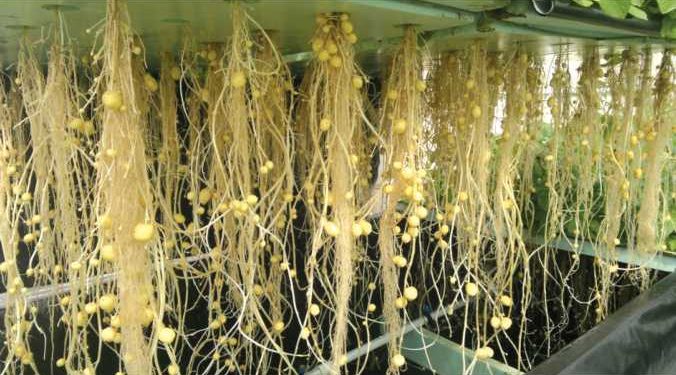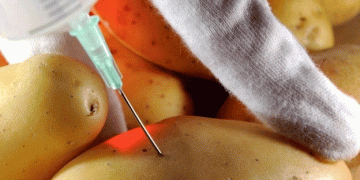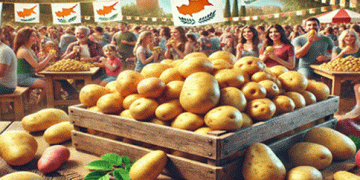In future, potato has to emerge from just a vegetable to serious food security option. Considering limited availability of cultivable land in the country higher potato production has to be led by growth in productivity. Future roadmap of potato R&D at CPRI would be primarily focused on enhancing potato productivity to 34.51 t/ha by the year 2050. The second focus of the institute will be to improve quality of potato as desired by the industry as well as potato consumers in the era of economic development, higher purchasing power and willingness to pay more for the desired quality. Research on improved potato storage will be targeted as another vital component in order to lower post-harvest losses during the next 40 years.
Strategy for achieving targets
In order to meet targets and tackle anticipated challenges, following seven-pronged strategy would be employed to accomplish the goals set in the vision.
- Effective exploitation of genetic resources for varietal improvement
• Molecular characterization and development of core collection of the germplasm.
Pre-breeding and genetic enhancement of potato
Wild Solanum species are a rich source of diversity for various biotic or abiotic stresses, and desirable agronomic traits which still remain untapped. For broadening genetic base of cultivated potato, it is urgently needed that the genetic potential of these wild species is harnessed to enhance potato production in order to address the food security issues in a sustainable way. International collaborations are required in terms of utilization of wild germplasm for conservation and sustainable use of wild species, access to wild species genetic diversity, gene mining activities by genomics tools, systematic and integrated strategy for evaluation, characterization of a range of traits, population development, and use of molecular/genomics tools for potato improvement.
Therefore, pre-breeding research at CPRI would be mainly focused towards acquisition of wild species from international gene-banks, evaluation of those wild species for various desirable traits, development of elite genetic stocks by somatic hybridization and 2n gametes fusion, mapping population for selected traits, core collection and linked molecular markers leading to break yield barriers in potato.
• Development of mapping population and pre-breeding including somatic hybrids for exploiting wider gene pool.
• Heterosis and hybrid vigour leading to enhancement in production potential of potato.
Hybrid Potato
Although all potato varieties developed worldwide are hybrids but hybrid vigour/heterosis is not harnessed to its fullest potential as the parental lines are not in-breds/pure lines. True potato seeds (TPS) produced sexually holds a great promise for growing potato from botanical seeds instead of tubers. Almost all viruses are unable to infect TPS with desirable escape from deterioration of seed quality. One of the problems with breeding potato varieties which can be propagated and grown from true seed is lack of uniformity in agronomic traits. The heterogeneous nature of TPS is due to the heterozygous nature of parents. Pure lines/in- bred parental lines cannot be produced in potato due to high inbreeding depression & selfincompatibility. In semi-cultivated potato, the self-incompatibility inhibitor gene (Sle) is known. This gene can be edited in cultivated potato by CASPER-CAs techniques for producing trait specific homozygous parents for harnessing hybrid vigour.
• Development of potato varieties and populations for short duration, processing, starch making, heat & drought tolerance, biotic stress tolerance, nutrient use efficiency, kharif season, exports, early bulking, and TPS populations.
2. Safe application of biotechnology for potato improvement
- Structural genomics and bioinformatics for developing robust molecular markers for qualitative and quantitative traits.
- Functional genomics for gene discovery for targeted traits like late blight durable resistance, heat tolerance, high temperature tuberization, better water and nutrient use efficiency.
- Proteomics and metabolomics for basic studies on tuberization, photosynthesis, partitioning of photo-assimilates, starch metabolism, carotenoid and flavonoid synthesis, storage protein quality, processing quality.
- Technology development for marker-free and site-specific integration of transgenes.
- Development of transgenic potato with improved resistance/ tolerance to biotic/abiotic stresses and to improve nutritional and processing quality.
3. Encouraging production of quality planting material
- Development & standardization of low cost and efficient mass propagation methods – aeroponics, bio-reactor technology.
Breeders seed production
Currently CPRI produces about 30,000 quintals nucleus and breeder seed every year which is only sufficient to meet the demand of healthy seed potato in the country. However, keeping in view the production of 125 million tonne of potatoes from 3.62 million ha by 2050, this supply of breeder’s seed is likely to fall short of the demand. CPRI targets to produce nucleus and breeder seed during 2020, 2030, 2040 and 2050 equal to 33,000, 36,000, 39,000 and 42,000 quintals, respectively. As there is limited scope to increase quantity of breeder seed at CPRI farms due to limitation of additional availability of land for seed production therefore, collaborations with other government organizations e.g. SAUs is being explored.
• Vector dynamics and its implications on seed quality.
• Development of homozygous TPS populations using apomixes and monohaploidy
4. Resource based planning and crop management
- Development of IT based Decision Support Systems/tools for crop scheduling and management of weeds, nutrients, water, diseases and pest sunder climate change scenario.
- Standardization of technologies leading to improved carbon sequestration and soil health.
- Development of technologies for enhancing inputs use efficiency through precision farming and micro-irrigation.
Micro-irrigation in potato
Micro-irrigation (drip and sprinkler) enables high frequency application of water in and around root zone of the plants. This system is useful for fertilizer and pesticides application resulting in efficient use of production inputs. Potato has a sparse and shallow root system and nearly 70% of total water is used by the crop from upper 30 cm soil layer. It requires 400-600 mm of irrigation water depending on climatic conditions, soil type, length of growing season, duration of variety, purpose of crop and methods of irrigation etc. The CPRI has developed technology of micro-irrigation for use in potato crop. Through fertigation nutrients are applied with irrigation (drip) near the root zone of the plants for providing optimum moisture and nutrients throughout the crop growth period. Sprinkler fertigation is also a new technique where nutrient particularly nitrogen is applied through sprinkler by foliar spray directly to the foliage.These methods of irrigation/fertigation economise on water (about 30-50% saving) at the same time giving 15-30 higher yield with upto 25% saving on fertilizers. The technology has been adopted by potato farmers in different parts of the country, however, Gujarat may be considered a role model for adoption of modern methods of irrigation as the state has the highest adoption of micro-irrigation technology including in potato crop. Consequently Gujarat has the highest potato productivity in India.
5. Eco-friendly crop protection
- Cataloguing genome variability and dynamics of new pathogen/ pests populations (Pathogenomics).
- Development of diagnostics for detection of pathogens both at laboratory & field level using micro-array and nano-technologies.
- Ecology and management of beneficial microorganisms for enhancing crop productivity and disease management.
Portable dipstick kits
The institute developed portable dipstick kits for field level detection of major potato viruses based on lateral flow immuno assay for single or a combination of two viruses. These kits are portable and easy to use by any stakeholder including farmers at field level for ascertaining health standard of the potato crop. The kits were released by Hon’ble Minister of Agriculture on Foundation day of ICAR after having been validated at AICRP (P) centres and by the progressive growers.
6. Encouraging energy efficient storage and diversified utilization of potato
- Technology refinement for elevated temperature storage for both on- and off-farm situation.
- Development of new processes, products and utilization technologies for diversified use of potatoes including waste utilization.
- Food fortification to enhance nutritional quality of processed foods.
- Technologies for lowering glycemic index.
7. Strengthening institute-farmer interface for technology dissemination
- Comparative farm profitability studies vis-a-vis ability to contribute to GDP by various crops, for providing efficient policy input.
- Proficient technical dissemination through an optimal mix of traditional and modern extension tools.
Cutting Edge Research Themes
CPRI will use following cutting edge research themes for its future R&D agenda.
• Development of transgenic potatoes to address high risk areas viz. biotic and abiotic stresses, quality enhancement and wider adaptation.
Early maturing day neutral varieties
Future emphasis of the institute would be on exploiting technologies like genomics, transcriptomics and other-omics in the field of potato improvement. The genes and alleles are known for tuberization and maturity and therefore, in the near future it will be very well be endevoured to develop varieties that mature in 50-60 days and capable of being fitted in various crop sequences.
• Processing sector: development of cold chipping varieties.
• Seed sector: production of seed potatoes in non-traditional areas.
• Health sector: development of potatoes with low glycaemic index and high antioxidant contents.
• Identification of new genes and markers for important traits.
• Fully automatic potato harvester to economize on labour.
• Studies on potato proteomics and phenomics with reference to tuberization.
• The next generation molecular marker, SNP, with reference to disease resistance and quality traits, will be developed by allele mining and resequencing.
• Bio-risk intelligent system (surveillance of racial pattern of different pathogens and pests and early warning systems) would be developed for taking informed decision at the local, regional and national levels.
• ICT, GIS and remote sensing options will be used to understand and mitigate ill effects of climate change & global warming, identify new potato growing areas and to develop decision support systems to meet impending complex challenges.
Relevance of CPRI by 2050
Under the influence of rapid privatization and disinvestment of government run institutions, it is obvious to think whether government sector institutes like CPRI will remain relevant by 2050 or not? The answer is not simple and straight forward. It is sure that such institutes will have to depend heavily on self-generated resources through private collaborations, consultancy projects and delivering customised solutions for their very survival. CPRI has already started commercialization of its technologies like aeroponics and bio fertilizers (B-5) etc. The extraordinary ability of the institute to quickly respond and adjust to the new situation makes it a fit candidate not only to survive by 2050 but the institute is expected to emerge as a centre of excellence in potato R&D at global level by that time.
CPRI has enough preparedness, not only to retain its position as a premier potato R&D organisation of the country, but also to emerge as leading global research establishment. This confidence is not just out of the wishful thinking, but based upon the world class facilities created at the institute with the hard work of several years. By being the Indian member of the consortium of 26 international institutes belonging to 14 countries for deciphering potato genome and by publishing the output in the globally leading scientific publication ‘Nature’, CPRI has already commenced its journey towards this destination. By the year 2050 CPRI would not be just a contributing partner in the multinational potato research projects but it would act as research leader for global potato R&D, especially the tropics and sub-tropics.






